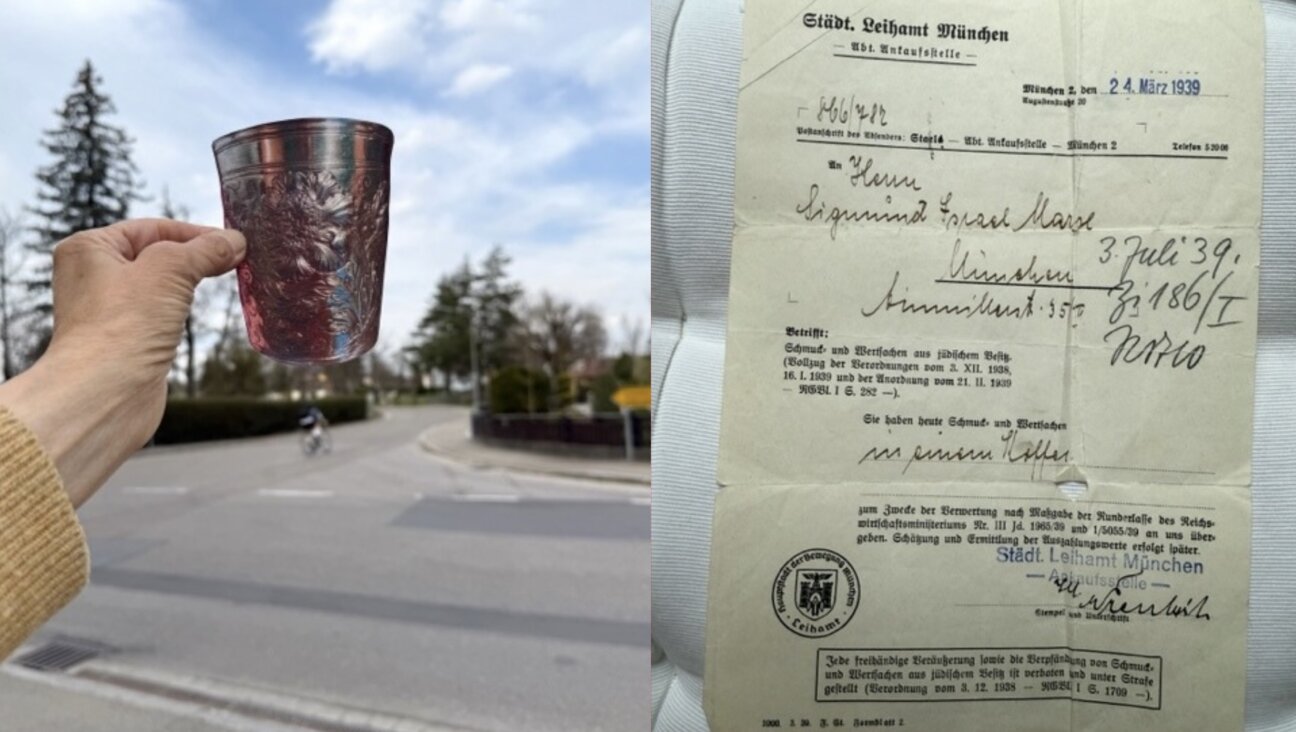Is Birthright Israel an Intermarriage Panacea?
Move over Jewish day schools. There’s a new intermarriage panacea in town, and its name is Birthright Israel.
A just-released study from a research team at Brandeis University led by Leonard Saxe found that 72% of married, non-Orthodox Birthright Israel participants have wedded fellow Jews, compared to just 46% of their peers who did not go on the trip.
For a community desperately seeking an intermarriage preventative, this is gold. Not only does Birthright appear to work, but it only takes 10 days, and it costs far less per person than tuition at a Jewish day school.
Young Jews are standing by right now who want to take a Birthright trip but have been waitlisted because there are not enough resources to send them all. So why shouldn’t the program fundraise around the headlines generated by this study, i.e. “Birthright Israel prevents intermarriage”?
Over the years, Saxe and his team of researchers have been at the forefront of painting a more nuanced sociological portrait of intermarried families and their children. In this new report, too, there is nuance beyond the headlines: The researchers quote Birthright participants from intermarried households, and show findings that include the increased desire to raise Jewish children among all participants, including children of intermarriage. In-marriage is seen as a measurement of increased Jewish identity, a byproduct of success and not the end itself.
That nuanced view, however, did not seem to be shared by all who spoke at the report’s unveiling to the assembled luminaries of Jewish philanthropy on October 26 at Brandeis House in New York. Steven Cohen of Hebrew Union College, who was not involved in the study, described the Jewish future as “a race between Birthright and intermarriage.” Overall, there was a sense that we have finally figured out how to put the intermarriage genie back in the bottle.
But the notion that we can somehow make intermarriage go away, or at least make it numerically insignificant, reflects a failure to grasp the magnitude of the phenomenon. And that failure begins with the way we look at intermarriage statistics.
There are always two numbers to look at regarding intermarriage: the percent of Jews who are intermarrying (the “individual rate”), and what the results of those marriages mean in terms of actual households created (the “couples rate”).
Imagine there are only four Jews in America, Bob and Carol and Ted and Alice. Let’s say that Bob and Carol intermarry and Ted and Alice in-marry. Since two of the four Jews intermarried, the “individual” intermarriage rate is 50%. But how many couples were created? Bob and Carol both married non-Jews, creating two households. But Ted and Alice married each other, because an in-marriage requires two Jews, which creates just one household. The result is three households total, with two intermarried and one in-married, or an intermarried couples proportion of two-thirds.
When intermarriage is explained as “almost half the Jews are intermarrying” — in other words, just offering the individual rate for what’s been happening in the United States for the past quarter-century — the word “half,” as huge as that may seem, actually serves to mask the results. The reality on the ground is that nearly double the number of intermarried households has been created compared to in-married households.
Telling half the story on intermarriage was particularly evident in our communal discussion of the 2000-01 National Jewish Population Survey, which reported an individual intermarriage rate of 47%. Largely ignored was the result of that rate, which was that the total number of intermarried couples was increasing faster than in-married couples, and had drawn nearly even. By now, almost a decade later, there are undoubtedly more intermarried than in-married households in the United States, and more children below the age of 18 who were born to intermarried than in-married parents.
There is no question that the 28% (individual) intermarriage rate among Birthright Israel alumni is remarkably low. But armed with an understanding of the couples’ rate, we can recognize that even if Birthright is miraculously able to bring the entire national intermarriage rate down to 28%, it would still mean nearly as many intermarried households created as in-married households, at a ratio of seven intermarried for every nine in-married households created (a 44% intermarried couples rate). That is hardly a “cure” for intermarriage.
Whether by design or not, Birthright Israel is the largest, most successful outreach program to young-adult children of intermarriage, having reached tens of thousands of such individuals. The program deserves increased financial support. But an effort to sell Birthright to funders around the idea that it prevents intermarriage would be disastrous, potentially alienating the very people who benefit most from the program.
Unfortunately, the focus on Birthright participants’ low intermarriage rate reignites our collective tendency toward insularity, the temptation to try to create a closed community. The real cure for 21st-century Judaism is to move beyond ethnic definitions and open our tradition, culture and learning to all who would find meaning and value in joining us.
Paul Golin is associate executive director of the Jewish Outreach Institute.
The Forward is free to read, but it isn’t free to produce

I hope you appreciated this article. Before you go, I’d like to ask you to please support the Forward.
Now more than ever, American Jews need independent news they can trust, with reporting driven by truth, not ideology. We serve you, not any ideological agenda.
At a time when other newsrooms are closing or cutting back, the Forward has removed its paywall and invested additional resources to report on the ground from Israel and around the U.S. on the impact of the war, rising antisemitism and polarized discourse.
This is a great time to support independent Jewish journalism you rely on. Make a gift today!
— Rachel Fishman Feddersen, Publisher and CEO
Support our mission to tell the Jewish story fully and fairly.
Most Popular
- 1

Opinion The dangerous Nazi legend behind Trump’s ruthless grab for power
- 2

Culture Did this Jewish literary titan have the right idea about Harry Potter and J.K. Rowling after all?
- 3

Opinion A Holocaust perpetrator was just celebrated on US soil. I think I know why no one objected.
- 4

Opinion I first met Netanyahu in 1988. Here’s how he became the most destructive leader in Israel’s history.
In Case You Missed It
-

Culture In Germany, a Jewish family is reunited with a treasured family object — but also a sense of exile
-

Opinion Trump’s heedless approach to an Iran deal could be a big problem for Israel
-

Fast Forward In NYC, Itamar Ben-Gvir says he’s changed — and wants ‘the Trump plan’ in Gaza
-

Opinion Itamar Ben-Gvir’s visit to a Jewish society at Yale exposed deep rifts between US Jews
-
Shop the Forward Store
100% of profits support our journalism
Republish This Story
Please read before republishing
We’re happy to make this story available to republish for free, unless it originated with JTA, Haaretz or another publication (as indicated on the article) and as long as you follow our guidelines.
You must comply with the following:
- Credit the Forward
- Retain our pixel
- Preserve our canonical link in Google search
- Add a noindex tag in Google search
See our full guidelines for more information, and this guide for detail about canonical URLs.
To republish, copy the HTML by clicking on the yellow button to the right; it includes our tracking pixel, all paragraph styles and hyperlinks, the author byline and credit to the Forward. It does not include images; to avoid copyright violations, you must add them manually, following our guidelines. Please email us at [email protected], subject line “republish,” with any questions or to let us know what stories you’re picking up.












